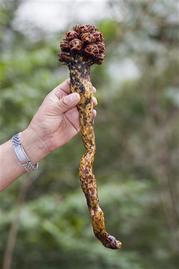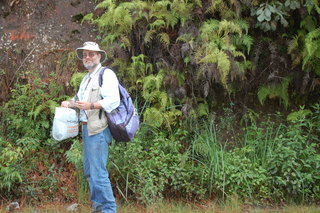
May 6, 2008

On May 2nd, I ran the story here about George Yatskievych, the scientist with the Missouri Botanical Garden who has rediscovered and identified a rare parasitic plant (above). A single specimen of the plant was found in Mexico in 1985. The plant wasn’t seen again until St. Louis botanist George Yatskievych and a colleague found it in a pine oak forest in Mexico’s mountains.
George Yatskievych studying the parasite in Mexico. Photo by J. L. Contreras J./ courtesy Missouri Botanical Garden.
However, a riddle for me was why I could not find the new scientific (Latin) name attached to any of the mainstream news reports of the discovery.

A recent photograph of George Yatskievych, Ph.D., Curator at the Missouri Botanical Garden, shows him collecting in the field.
I decided to ask George Yatskievych, directly.
Now, in this exclusive, here is the proposed name of the new plant: Eremitilla mexicana.
Yatskievych wrote me late last night:
Thanks for the message and kind thoughts.
Because the scholarly paper officially describing the new genus has not been published yet, I requested that the news story not include its scientific name.
We are planning to call the new plant Eremitilla mexicana, which translates literally as “the little hermit of Mexico.” You won’t find any information on the web under this scientific name, as it doesn’t officially exist yet. ~ George Yatskievych
Just to be complete, I should note that Daniel Cressey at the Great Beyond last week speculated that the name would be Eremitiala Mexicana, as the “little hermit of Mexico” was mentioned by the media. The “m,” however, should not be capitalized. Yatskievych’s email confirms the plant hopefully will be named Eremitilla mexicana in his forthcoming journal article.
As Chad Arment correctly points out to me in an email, because the name has not been officially published, it is may be a nomen nudum.
The phrase nomen nudum is a Latin term, meaning “naked name.” In taxonomy, this is used to indicate a term or phrase which looks like a scientific name, and may well have been intended to become a scientific name, but fails to be one because it was not (or not yet) published with an adequate description (or a reference to such a description), and thus is “bare” or “naked”.
Because a nomen nudum fails to qualify as a formal scientific name, a later author may publish a real scientific name that is identical in spelling. If the same author publishes a name first as a nomen nudum and later accompanied by a valid description, the date of publication of the latter, valid, description becomes the taxon’s date of establishment.
The nomen nudum is to be differentiated from the nomen dubium.
In zoological nomenclature, a nomen dubium (Latin for “doubtful name”, plural nomina dubia) is a scientific name that is of unknown or doubtful application. Note that in the ICBN and ICNB the phrase “nomen dubium” has no status.
In case of a nomen dubium, it may be impossible to determine whether a specimen belongs to that group or not. This may happen if the original type specimen, or holotype, is lost or destroyed. All codes of nomenclature allow for a new type specimen, or neotype, to be chosen in this case.

George Yatskievych, in earlier days, while collecting.
About Loren Coleman
Loren Coleman is one of the world’s leading cryptozoologists, some say “the” leading living cryptozoologist. Certainly, he is acknowledged as the current living American researcher and writer who has most popularized cryptozoology in the late 20th and early 21st centuries.
Starting his fieldwork and investigations in 1960, after traveling and trekking extensively in pursuit of cryptozoological mysteries, Coleman began writing to share his experiences in 1969. An honorary member of Ivan T. Sanderson’s Society for the Investigation of the Unexplained in the 1970s, Coleman has been bestowed with similar honorary memberships of the North Idaho College Cryptozoology Club in 1983, and in subsequent years, that of the British Columbia Scientific Cryptozoology Club, CryptoSafari International, and other international organizations. He was also a Life Member and Benefactor of the International Society of Cryptozoology (now-defunct).
Loren Coleman’s daily blog, as a member of the Cryptomundo Team, served as an ongoing avenue of communication for the ever-growing body of cryptozoo news from 2005 through 2013. He returned as an infrequent contributor beginning Halloween week of 2015.
Coleman is the founder in 2003, and current director of the International Cryptozoology Museum in Portland, Maine.
Filed under Breaking News, Cryptobotany, Cryptomundo Exclusive, Cryptotourism, CryptoZoo News, Cryptozoology, New Species